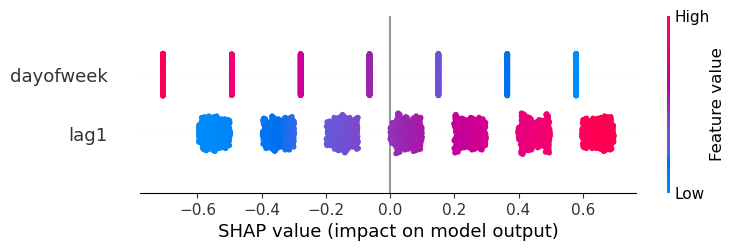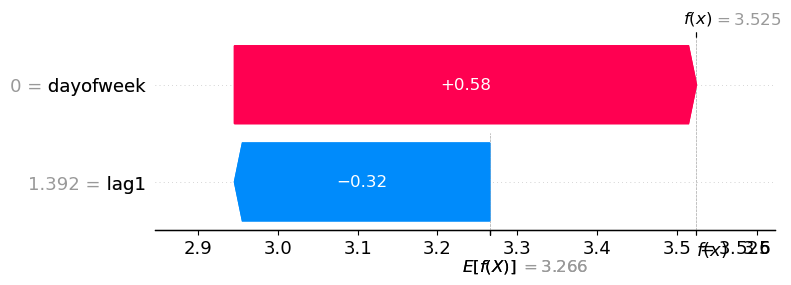Data setup
| unique_id | ds | y | |
|---|---|---|---|
| 0 | id_0 | 2000-01-01 | 0.322947 |
| 1 | id_0 | 2000-01-02 | 1.218794 |
| 2 | id_0 | 2000-01-03 | 2.445887 |
| 3 | id_0 | 2000-01-04 | 3.481831 |
| 4 | id_0 | 2000-01-05 | 4.191721 |
Training
Suppose that you want to train a linear regression model using the day of the week and lag1 as features.MLForecast.fit
does is save the required data for the predict step and also train the
models (in this case the linear regression). The trained models are
available in the MLForecast.models_ attribute, which is a dictionary
where the keys are the model names and the values are the model
themselves.
Inspect parameters
We can access the linear regression coefficients in the following way:SHAP
Training set
If you need to generate the training data you can useMLForecast.preprocess.
| unique_id | ds | y | lag1 | dayofweek | |
|---|---|---|---|---|---|
| 1 | id_0 | 2000-01-02 | 1.218794 | 0.322947 | 6 |
| 2 | id_0 | 2000-01-03 | 2.445887 | 1.218794 | 0 |
| 3 | id_0 | 2000-01-04 | 3.481831 | 2.445887 | 1 |
| 4 | id_0 | 2000-01-05 | 4.191721 | 3.481831 | 2 |
| 5 | id_0 | 2000-01-06 | 5.395863 | 4.191721 | 3 |
| lag1 | dayofweek | |
|---|---|---|
| 1 | 0.322947 | 6 |
| 2 | 1.218794 | 0 |
| 3 | 2.445887 | 1 |
| 4 | 3.481831 | 2 |
| 5 | 4.191721 | 3 |

Predictions
Sometimes you want to determine why the model gave a specific prediction. In order to do this you need the input features, which aren’t returned by default, but you can retrieve them using a callback.| unique_id | ds | lr | |
|---|---|---|---|
| 0 | id_0 | 2000-08-10 | 3.468643 |
| 1 | id_1 | 2000-04-07 | 3.016877 |
| 2 | id_2 | 2000-06-16 | 2.815249 |
| 3 | id_3 | 2000-08-30 | 4.048894 |
| 4 | id_4 | 2001-01-08 | 3.524532 |
SaveFeatures.get_features
| lag1 | dayofweek | |
|---|---|---|
| 0 | 4.343744 | 3 |
| 1 | 3.150799 | 4 |
| 2 | 2.137412 | 4 |
| 3 | 6.182456 | 2 |
| 4 | 1.391698 | 0 |
'id_4'.


